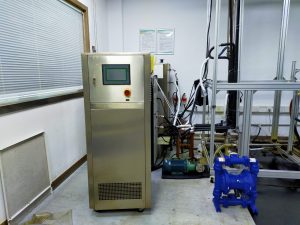All analysis of refrigerant changing process of industrial chiller unit
Refrigerant is an indispensable part of the refrigeration system of the industrial chiller. During the operation of the industrial refrigeration unit, the refrigerant constantly changes in the industrial refrigeration unit to achieve the cooling effect, so what changes have occurred in the industrial refrigeration unit refrigerant!
Let me introduce you to the process of refrigerant changes in industrial refrigeration units. What are the relevant contents?
Refrigerant change process of industrial refrigeration unit:
The whole process of refrigerant compression
When the bottom pressure refrigerant vapor enters the tail end of the air conditioner evaporator of the industrial chiller to the refrigeration compressor and is reduced to work, its working pressure quickly rises to the cold working pressure, because the refrigerant vapor is reduced and discharged in an instant Come out, so the heat will not be transferred to the external natural environment, you can feel that this is a whole process of insulation reduction.
The whole process of refrigerant cooling
After the refrigerant high-pressure saturated steam enters the cooler of the industrial chiller, the cooler will continuously take out the heat in the refrigerant, and then the refrigerant will be converted from the high-pressure saturated steam to saturated water vapor, and will change during the continuous cooling process. Saturated liquid refrigerant.
Refrigerant throttling process
When the liquid refrigerant in the saturated state passes through the throttling devices of the industrial chiller, such as capillaries and expansion valves, the working pressure of the refrigerant is quickly released, and the temperature of the refrigerant slowly decreases to the volatilization temperature. At this time, the refrigerant (refrigerant) is in a state where the liquid phase and the high-efficiency liquid phase coexist, but the refrigerant liquid accounts for the vast majority, and the refrigerant vapor accounts for a relatively small part.
The whole process of refrigerant evaporation and heat absorption
After the refrigerant enters the air conditioner evaporator of the industrial chiller from the throttling device, the vapor-liquid compound continuously digests and absorbs the heat generated from the refrigerant in the circulation system and vaporizes into a vapor refrigerant, the refrigerant (water, B Glycol or salt water) is continuously cooled and the cooling capacity is output to the operating machinery and equipment, and the volatile refrigerant is sucked into the refrigeration compressor to carry out the next process of reducing the circulation system.
Refrigerant is an indispensable part of the refrigeration unit of industrial chillers, and people often call it refrigerant (also known as refrigerant). During the entire operation process, the refrigerant continuously circulates in the refrigeration unit of the industrial chiller and changes according to its own conditions to maintain the cooling effect. The refrigerant digests and absorbs the heat generated by the refrigerated substance (water, gas, etc.) in the air conditioner evaporator and vaporizes, and transfers the heat to the surrounding gas or water in the cooler for suspicion. Its characteristics are immediately related to the actual cooling effect, rationality, safety factor and operation management method of the refrigeration equipment, so it is necessary to have a certain grasp of the characteristics of the refrigerant.
The main uses of refrigerants are very common, and there are many types. At this stage, there have been more than 80 kinds, and they are continuously increasing. Among them, there are more than ten kinds of foods. The main uses are wide range R12, R22, R717, R134a, R404A, R407C, and R22 are more used in industrial chillers.
The above is the editor’s introduction to the process of refrigerant changes in industrial refrigeration units! I believe that everyone should already know something. Today I will introduce so much to you. If you still do n’t understand anything, I will always answer it for you!
Recommandations connexes
-
Comparison of Three Test Methods for Low Temperature Chamber
12082. Non-heat dissipation test samples and heat dissipation test samples When the temperature of the test sample is stable during the conditional test period, the hottest spot temperature on the surface of the test sample is higher than the ambient ...
Voir les détails -
Working Principle and Process of Chiller Temperature Control and Pressure Controller
1602Air cooled chiller temperature controller is a two - position regulator, also known as chiller temperature control relay.According to the change of adjusted temperature,the chiller temperature control makes the contact on or off, thus controlling ...
Voir les détails -
Explosion-proof high and low temperature integrated machine advantage
1185Explosion-proof high and low temperature integrated machines are used in the current pharmaceutical and chemical industry. The heat transfer medium of the entire circulation system is a fully closed cycle, the circulation system has a liquid expan...
Voir les détails -
How to control the emulsification temperature of the emulsifier?
991A good cream product is not only reflected in the quality of raw materials, but also has a great influence on the emulsification process during production, such as the texture and stability of the product, and the temperature control during produc...
Voir les détails
 LNEYA Industrial Chillers Fabricant Fournisseur
LNEYA Industrial Chillers Fabricant Fournisseur











